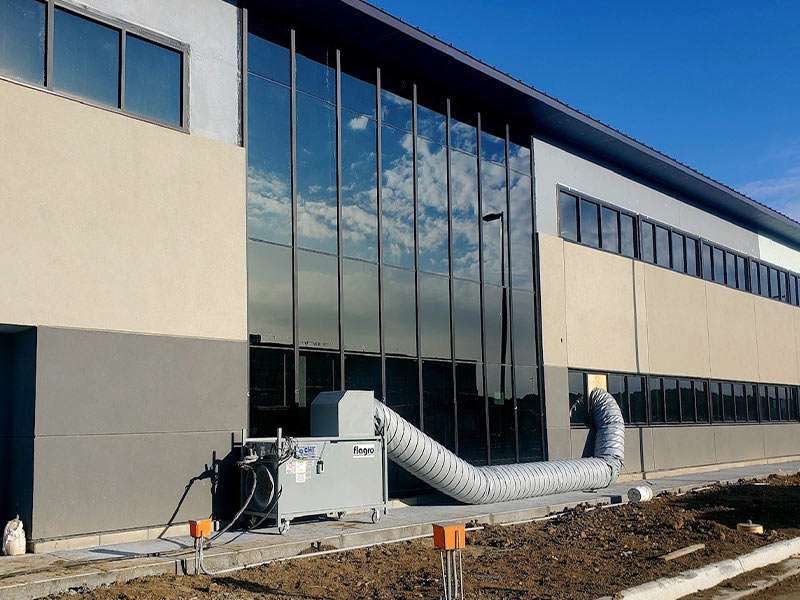Climate plays a crucial role in construction projects, influencing the choice of materials, project timeline, and the durability of the constructed building. For regions experiencing seasonal temperature changes, it’s essential to understand how these fluctuations affect materials, costs, and expenditures. Partnering with an experienced team is critical to designing and recommending the correct solutions tailored to your project needs. CHI offers expert service and a comprehensive range of rentals and temperature control accessories to ensure the success of your project.
Autumn—Winter: During the colder months of autumn and winter, construction sites face classic dangers such as slipping hazards, electricity issues, and personnel exposure to the elements. Construction sites can become death traps if not adequately managed, as water freezing and melting can increase the risk of electrical accidents.
Moisture: Moisture poses significant challenges on construction sites, affecting various materials commonly used in construction. Wood, paint, and glue often encounter moisture issues, leading to potential damage and deterioration. Metals are susceptible to rust when exposed to moisture. Brick is usually the first building material affected by trapped moisture during construction, which can lead to issues later. Even indoor paint and glue can accumulate mold due to humidity, underscoring the importance of selecting adhesives suitable for humid construction site conditions. Addressing moisture-related challenges is vital to ensuring the integrity and longevity of construction projects.
Thunderstorms: Heavy rains and thunderstorms pose significant risks to construction sites. These events are often accompanied by high winds, which can result in material damage. Hail associated with thunderstorms can break glass or dent sheet metal.
Extreme Cold: Many construction materials, including concrete, cement, paint, and glue, tend to contract in extremely cold temperatures. However, when these materials expand, they risk cracking.
Spring—Summer: Summer should not be underestimated, as it poses several challenges. While spring may bring warmer temperatures, moisture issues and rain persist. Moisture becomes a more significant concern in spring, combining warmer weather and increased precipitation.
Heat: Heat can alter the expansion dimensions of materials, resulting in misaligned joints during construction. Concrete preparation on hot days without accounting for rainwater requirements can lead to weaker applications. Additionally, bricks may become brittle, while paint can crinkle, crack, and discolor in intense heat.
Climate change has impacted everyone, with many regions experiencing extreme winters, summers, unpredictable temperature changes, and even midseason. The main challenge for the construction industry is adapting and evolving in response to these shifts. To address this challenge, new materials are being developed to withstand extreme temperature variations while maintaining their core strength.
Seasonal temperature changes profoundly affect equipment, personnel, materials, planning, and application in the construction industry. Environmental conditions influence each construction branch, beginning at the planning stage. Thoughtful planning involves considering each of these issues to ensure successful project execution.
A great planning team will integrate risk factors stemming from expected changes in climate and temperature conditions. Materials selected for construction will be chosen based on their properties and ability to withstand such changes over time. Using suitable materials for your location is crucial, as climates have changed radically, and relying on outdated assumptions may lead to unforeseen challenges.
How We Can Help
Regardless of the season or project phase, CHI can design systems that provide solutions to keep your project on schedule. Our solutions result in a safer job site, reduced fuel/energy costs, increased worker productivity, enhanced curing times for moisture-sensitive materials, and a satisfied customer upon project completion.

